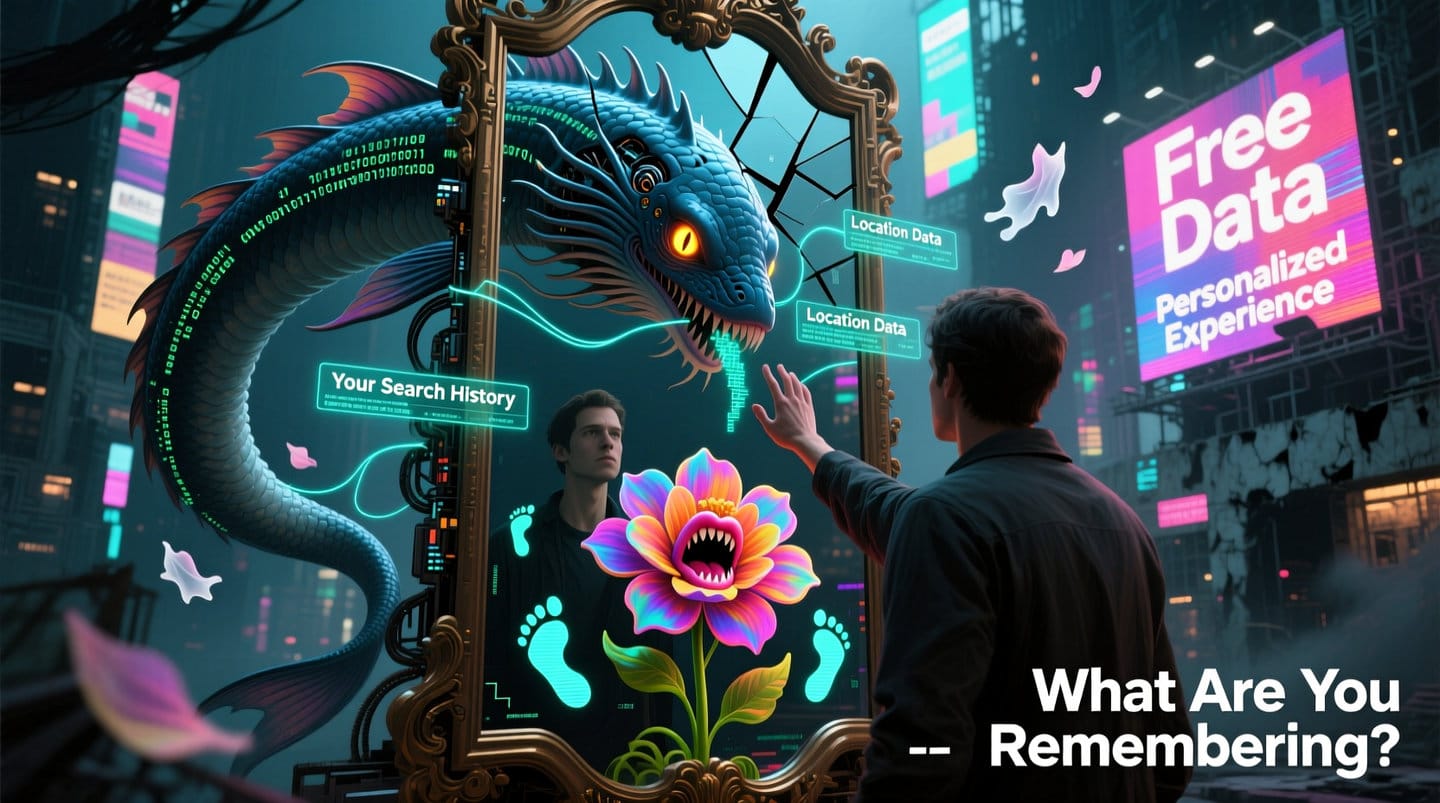Framed through the lens of P.D. Ouspensky's "In Search of the Miraculous"
By: Dr Spacequire, An Advocate for Digital Consciousness
Introduction: The Unseen Architect of Our Digital Lives
Every day, we live a second life—a digital shadow that mirrors, and often precedes, our physical one. We wake up and check the news, commute while streaming music, work through cloud-based applications, and socialize through encrypted messages. This life is facilitated by a silent architect: our Internet Service Provider (ISP) and mobile carrier.
Most of us interact with this digital realm in a state P.D. Ouspensky, in his seminal work In Search of the Miraculous, would call "waking sleep." We are active participants, but unconscious of the mechanisms that observe, record, and shape our experience. We click "Accept" on privacy policies we do not read, unaware of the vast, detailed portrait being painted of us in corporate data centers.
This article proposes a simple, yet profound act of awakening: formally requesting the data your Australian ISP holds about you. This is not merely a legal right; it is a modern ritual of self-study. It is an attempt to see the reflection of our digital soul in the corporate mirror, a crucial step toward transparency, trust, and ultimately, a more conscious existence in the connected world.
Part 1: The Philosophical Frame – The Search for the Miraculous in the Data Stream
Ouspensky’s book documents his search for a system of knowledge that could explain humanity's place in the universe. He found it in G.I. Gurdjieff's teachings, which posited that humanity is largely asleep, living mechanically, unaware of its true potential. The path to awakening required relentless self-observation and self-remembering.
Let us transpose this framework to our digital context:
- The Mechanical Man: The average internet user operates mechanically. Habits—scrolling, clicking, browsing—are performed without conscious awareness of the data exhaust they produce. We are the subject of the digital system, not its conscious director.
- The Digital False Personality: Our online profiles, curated feeds, and targeted advertisements create a "false personality"—a digital self constructed by algorithms based on our past behavior, designed to keep us engaged. This is not our true, multifaceted self, but a flattened, predictable consumer avatar.
- Self-Observation: The first step toward awakening is self-observation. In the digital realm, this means turning the gaze inward upon our own data trail. What does our browsing history actually say about our interests? What do our app usage logs reveal about our attention? To see this data is to see our digital habits without the filter of our self-image.
- The Shock of Seeing Ourselves: Gurdjieff spoke of the need for "shocks" to break mechanical routines. Receiving a comprehensive data file from your ISP can be precisely such a shock. The sheer volume, the intimate detail, the cold, metadata-driven account of your life can jolt you out of digital sleep. It makes the abstract tangible.
Requesting your data is, therefore, an act of "Digital Self-Remembering." It is an attempt to reclaim the knowledge of your own digital existence, to see the "I" that the machine sees, and in doing so, to begin the work of becoming a more conscious, intentional user of technology.
Part 2: The Practical Guide – How to Make a Data Access Request in Australia
The philosophical pursuit requires a practical tool. In Australia, this tool is provided by the Privacy Act 1988 and its Australian Privacy Principles (APPs). APP 12 grants you the legal right to access the personal information an organization holds about you.
Crafting Your Request: A Step-by-Step Guide
Your request must be clear, specific, and grounded in the law to be effective.
- Identify the Entity: You need to send separate, tailored requests to your residential broadband ISP (e.g., Telstra, Optus, TPG etc) and your mobile service provider (e.g., Telstra, Vodafone, amaysim ..). Even if it's the same company, treat them as separate requests.
- Locate the Privacy Officer: Do not send your request to general customer service. Find the dedicated contact for the Privacy Officer. This information is almost always in the company's "Privacy Policy" on their website. Look for a specific email (e.g.,
privacy@company.com.au) or a postal address for legal notices. - Use a Formal Template (The Incantation): The words you use matter. They signal that you are making a formal, legally-grounded request, not a casual inquiry.Subject: Formal Request for Access to Personal Information under APP 12Dear Privacy Officer,I am writing to make a formal request for access to my personal information under Australian Privacy Principle (APP) 12, as set out in the Privacy Act 1988 (Cth).My account details are as follows:
- Full Name: [Your Name]Service Address: [Your Address]Account Number: [Your Account Number]Contact Number: [Your Number]
- For Browsing History & Internet Use: Explicitly ask for "all web browsing history (full URLs) and Domain Name System (DNS) query logs." Many ISPs will claim they do not retain this by default for all users, but some may for "network management" or security purposes. Forcing them to state this explicitly is a victory for transparency.
- For Device & OS Information: Request "all recorded device specifications, including make, model, MAC addresses, serial numbers, IMEI numbers (for mobile), and any records of operating systems and their versions used on my network."
- For the Mandatory Data Retention Scheme: This is critical. Acknowledge it to show you are informed. Ask for "a copy of all telecommunications data (metadata) retained under the Telecommunications (Interception and Access) Act 1979, including source/destination of communications, date, time, duration, and location data (cell tower logs)." This data they are legally required to keep for two years.
- For Data Retention & Sharing: Go beyond the data itself. Ask: "Please also specify your data retention periods for each category of data and identify all third parties with whom you have shared my personal data, including the categories of data shared."
Yours faithfully,
[Your Signature & Printed Name] - Send and Record: Send your request via email (with a read receipt) or registered post. Keep a copy of everything.
Part 3: The Why – The Imperative for Awareness and the Pillars of Trust
Why should the average person undertake this seemingly bureaucratic task?
- To Break the Illusion of Anonymity: The internet feels private, but it is a recorded space. Seeing your own data shatters the illusion that your online activities are ephemeral or anonymous. This awareness is the foundation of digital literacy.
- To Audit Power: ISPs have immense power. They can see the patterns of your life. This data can be used for targeted advertising, but also sold to data brokers, or accessed by government agencies without your knowledge (via warrant or in some cases, without one). You cannot question or challenge uses of your data if you do not know what is collected.
- To Foster Transparency and Trust: Trust is not built on blind faith, but on verifiable transparency. When a company knows its customers can and will ask to see their data, it creates a powerful incentive for them to handle that data responsibly, to collect only what is necessary, and to be clear about their practices. Your request is a citizen's audit, a mechanism of accountability.
- To Inform Public Debate: The public understanding of data collection is often abstract and fear-based. When thousands of individuals receive their data, they can share their experiences (anonymously), creating a grassroots, evidence-based picture of corporate and government surveillance. This is invaluable for advocating for stronger privacy laws.
"It is necessary to understand that it is impossible to get something for nothing. What we get always corresponds to what we give." - Peter Ouspensky, In Search of the Miraculous
Part 4: The Path Forward – Striving for Simplicity and Speed
The current process—finding a specific email, drafting a formal letter, citing laws—is a barrier. It favors the persistent and the knowledgeable. For digital self-awareness to become mainstream, the process must be revolutionized.
We must strive for a system where:
- Access is a Default Feature, Not a Request: Imagine a dashboard in every ISP account portal: "Download Your Data." It should be as easy as downloading a bill.
- Data is Provided in a Standardized, Readable Format: Data should not be dumped in an incomprehensible technical format. It should be presented in a human-readable, searchable, and standardized layout (e.g., a well-designed PDF or interactive web page).
- The Right is Proactively Advertised: Companies should be required to inform customers of their APP 12 rights clearly and prominently, not bury it in a 50-page privacy policy.
Making this process easy and immediate is essential. The longer the delay between the act and the observation of its record, the less potent the "shock" of self-awareness becomes.
"In this apocalypse, there is no innocence, only varying degrees of complicity. Users are both victims and perpetrators, consumers and consumed. The ultimate flower power lies in recognizing this duality, in embracing the poisonous beauty of the system that enslaves us. Only then can we truly understand the nature of our digital selves—and perhaps, like Juliette, find pleasure in the abyss." ~ Marquise de Sade didn't say that
Part 5: Necessary Caveats – The Limits of the Mirror
As with any profound undertaking, one must be aware of the limitations.
- You May Not Like What You See: The data is a cold, dispassionate record. It may reveal habits you are not proud of or time-wasting you did not acknowledge. This is the point of self-observation, but it can be uncomfortable.
- The Response May Be Disappointing: You may receive a heavily redacted file, or be told that much of the data you requested is not retained for general customers. They may cite legal exemptions or commercial confidentiality. This, in itself, is a form of transparency—it reveals the limits of your access and the boundaries of corporate disclosure.
- The Data is a Shadow, Not the Substance: The data points to your behavior, but it is not your behavior. Do not confuse the map for the territory. The 100th entry in a browsing log is not you; it is a single, mechanical action of the sleeping personality. The goal is to use the map to understand the territory of your own digital consciousness.
Maintaining control over personal data contributes to mental well-being by reducing feelings of vulnerability and anxiety related to privacy breaches. Moreover, by being mindful of data sharing practices, individuals can enhance their digital security and protect themselves from potential risks such as identity theft or data misuse.
From Waking Sleep to Digital Awakening
In "In Search of the Miraculous," the path to consciousness begins with the sobering realization that we are not what we believe ourselves to be. The digital parallel is stark: the "you" that exists in the marketing algorithms and data warehouses is a simplistic, mechanistic model.
By filing an APP 12 request, you are not just a consumer exercising a right. You are a modern seeker, initiating a ritual of self-study. You are demanding to see the reflection of your digital self in the corporate mirror. This act, repeated by thousands, has the power to transform our relationship with technology—from one of passive consumption to one of conscious engagement. It is a small but vital step in the long search for the miraculous in an age of algorithms, a quest to wake up from our digital sleep.

DR SPACEQUIRE with JOHNNY MAGRITT @ APPLESEED.PRO:
Determine Your Course
If you require additional assistance feel free to reach out to our intelligence departments via booking a consultation herein. For a comprehensive analysis or to introduce yourself in a unique way. However, time is of the essence, and the effectiveness of this action remains uncertain. Act swiftly to address your IT needs! 🚀 #ITSolutions #TechSupport #InnovationInProgress #johhnyappleseedpro



